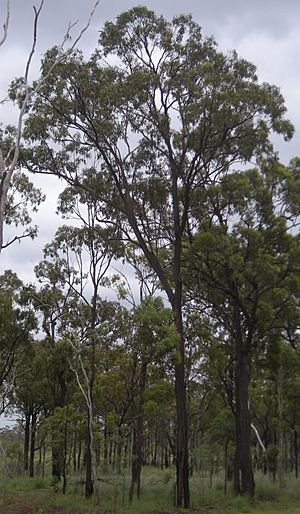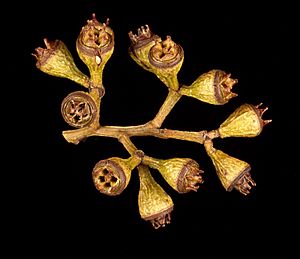Broad-leaved ironbark facts for kids
Quick facts for kids Broad-leaved Ironbark |
|
|---|---|
 |
|
| Eucalyptus fibrosa growing near Canoona, Queensland | |
| Scientific classification | |
| Genus: |
Eucalyptus
|
| Species: |
fibrosa
|
The Eucalyptus fibrosa, often called the red ironbark or broad-leaved red ironbark, is a medium to tall tree found only in eastern Australia. It has rough, grey to black bark that looks like iron. Its leaves are shaped like spears or eggs. The tree produces groups of seven to eleven flower buds, which open into white flowers. Later, it grows cone-shaped fruits.
Contents
About the Broad-leaved Ironbark Tree
The Broad-leaved Ironbark tree can grow up to 35 meters (about 115 feet) tall. It has a special woody swelling at its base called a lignotuber. This helps the tree regrow if it's damaged by fire.
Its bark is rough and grey to black, and it covers the trunk and even the thinner branches. This bark often looks like it's flaking off.
Young plants and new shoots (called coppice regrowth) have different leaves. These leaves are egg-shaped or triangular, about 80-200 mm (3-8 inches) long and 45-140 mm (1.8-5.5 inches) wide. They are slightly lighter green on one side.
Adult leaves are shaped like spears or eggs. They are the same shade of green on both sides. These leaves are usually 85-180 mm (3.3-7 inches) long and 15-45 mm (0.6-1.8 inches) wide. They grow on a stalk called a petiole, which is about 13-30 mm (0.5-1.2 inches) long.
The tree's flower buds grow in groups of seven, nine, or eleven. They are found at the ends of the branches. Each group of buds grows on a branching stalk called a peduncle, which is 9-20 mm (0.35-0.8 inches) long. Each individual bud has a smaller stalk called a pedicel, 2-8 mm (0.08-0.3 inches) long.
When the buds are ready to open, they are spindle-shaped (like a small spinning top). They are 8-17 mm (0.3-0.7 inches) long and 3-5 mm (0.1-0.2 inches) wide. Each bud has a cap called an operculum, which is shaped like a cone or a horn.
Broad-leaved Ironbark trees can flower in most months of the year, and their flowers are white. After flowering, the tree produces woody, cone-shaped fruits. These fruits are called capsules and are 5-10 mm (0.2-0.4 inches) long and wide.
Some other ironbark trees, like E. siderophloia, look similar. However, they usually have smaller buds and fruits, and their bud caps are much shorter than those of the Broad-leaved Ironbark.
How it Got its Name
The Eucalyptus fibrosa was first officially described in 1859. This was done by Ferdinand von Mueller, who was a state botanist in Victoria, Australia. He found the tree near the Brisbane River. His description was then published in a scientific journal called Journal and Proceedings of the Linnean Society, Botany.
The scientific name fibrosa (which means "fibrous") likely refers to the tree's bark. However, some people think this name might not be the best fit for an ironbark tree, as their bark is very hard, not really fibrous.
In 1962, two scientists, Lawrie Johnson and Robert Anderson, described two types (subspecies) of Eucalyptus fibrosa. These names are now officially accepted:
- Eucalyptus fibrosa subsp. fibrosa
- Eucalyptus fibrosa subsp. nubilis. This type is often called the blue-leaved ironbark. It is different because its buds and fruits have a glaucous (bluish-grey or whitish) coating. This subspecies was previously known by a different name, Eucalyptus nubilis.
Where it Lives
The red ironbark tree grows in forests where the soil is not very rich. It is found widely along the coast, on the tablelands (flat high lands), and in nearby inland areas of eastern Australia. You can find it from near Rockhampton in Queensland all the way down to Moruya in New South Wales.
Conservation Status
The Queensland Government lists the Broad-leaved Ironbark as a species of "least concern" under its Nature Conservation Act 1992. This means it is not currently considered to be at risk of disappearing.
Gallery
See also
 In Spanish: Corteza ferrosa de hojas anchas para niños
In Spanish: Corteza ferrosa de hojas anchas para niños





